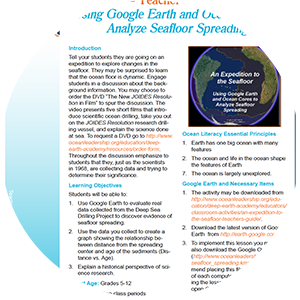Actvity Summary: Use Google Earth and ocean cores to analyze seafloor spreading
The goal of the Deep Sea Drilling Project was to investigate the sediments and rocks beneath the deep oceans by drilling and coring. The seafloor is usually made up of a thick layer of sediment. The sediment is composed of sand, silt, clay, and microfossils that drift down through the water. Microfossils are fossilized microscopic organisms. Common types include nannofossils, foraminifers, and diatoms. When microfossils are the major component of the sediment, then that sediment can be called an ooze. The sediment layer can be up to 2000 meters thick! Below the sediment is a layer of igneous rock, basalt, also called basement rock.
The data in this exercise were taken from sediment cores collected by the Glomar Challenger. In late 1968, scientists onboard the ship collected sediment core samples at seven sites east and west of the Mid-Atlantic Ridge. At each location, they discovered nannofossil oozes that had formed at different time intervals. The age of the sediment in contact with the basement rock at each location was used to date when that basement rock formed.
- Standard B: Science as inquiry
- Standard E: Earth and space science
